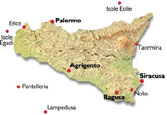 |
 |
|
Marsala (TP) | ||
|
||||||||
|
A long slow decline was halted in the 18th century, when an enterprising Englishman, John Woodhouse, started shipping the local wine to Liverpool; to fortify it for the journey he added brandy, which quickly made it a very popular drink in England! Business boomed, new players joined in - notably the Ingham, Whitaker, Hopps, Good and Florio families (the last being Sicilian rather than English): all were taken over by the Italian giant Cinzano - the Florio name was kept on as the brand name. For a more complete picture of Marsala wine check here. Garibaldi of course began his celebrated campaign here in 1860 - British warships were shadowing him to ensure that the wine trade remained unaffected!
The Museum is well up to the superb standard of Sicilian museums. The star exhibit is the "Punic ship". It's preserved in a vast plastic tent to prevent the timber drying out; through it the construction of the ship can be clearly seen, the only remains of an ancient warship so far discovered (the trireme for example had so much timber that it was virtually unsinkable - the wood would have been rescued and recycled). There are also interesting finds from the ship - most famously remains of cannabis which they say may have been used to motivate the rowers (unlikely in my opinion!). Remains of Roman Lilybaeum on Capo Boeo are extensive and can be visited. I was lucky to be escorted throughout by a personal guide, a beautiful blonde with short tartan skirt and black stockings; this made it a little difficult to concentrate on the huge 2nd century AD Roman villa ("destroyed by the Vandals") in a superb situation near the cape. The mosaics are reminiscent of those at Casale, Piazza Armerina, with a preponderance of bloodthirsty animal scenes - tigers leaping on antelopes etc. I was shown a "bath time" (I think it was the impluvium, in fact) and a large pot sunk into the earth which she assured me was a "vomitatorium". I notice that even the Blue Guide mentions a vomitorium as if a vast puke-basin were an established feature of a Roman private villa! (As all good classicists know a vomitorium was what The Romans called the exits from an amphitheatre: brilliantly designed to empty the building in a few minutes; unlike a modern stadium where it can take an hour or so to get away after an event).
For complete details of the history of Lilybaeum, and of Carthaginian involvement in Sicily generally, visit the excellent http://www.livius.org/ha-hd/hamilcar/hamilcar2.html
|
 |
Use the table below to find your way around Sicily: |  |
||||||||||
| Map | Index | PA | ME | CT | EN | CL | SR | RG | AG | TP | ||
Printer friendly page: click to print
| What's new? | Search the site? | Main Index? | Bookshop? | Top of Page? | ||||
|
The Classics Pages are written and designed
by Comments, questions and contributions welcome. |
||||||||